
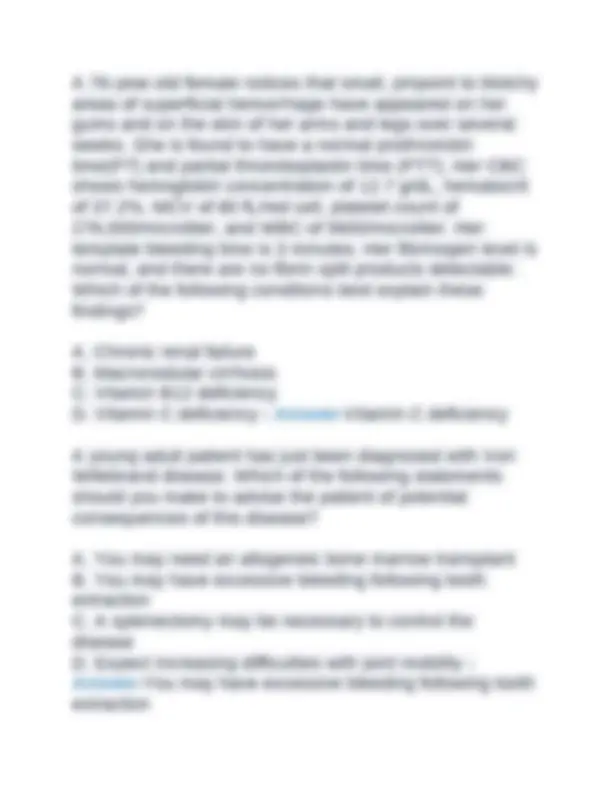
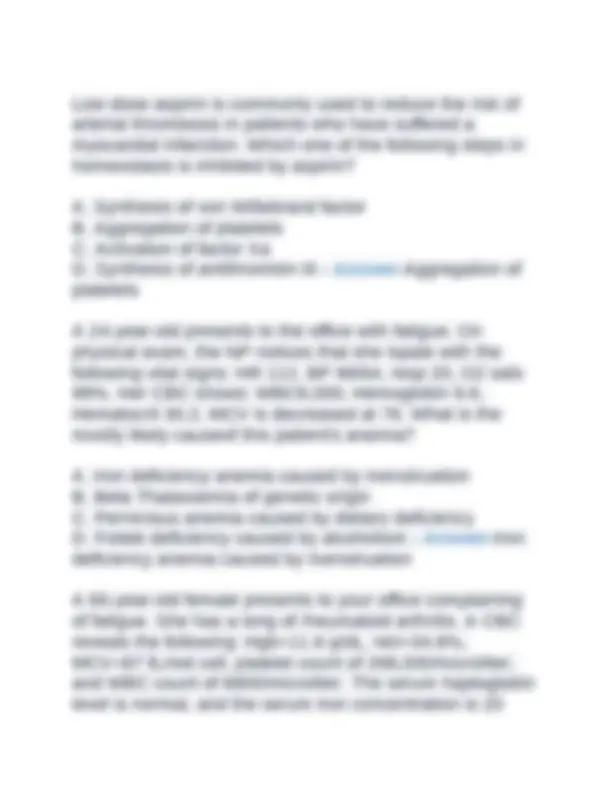
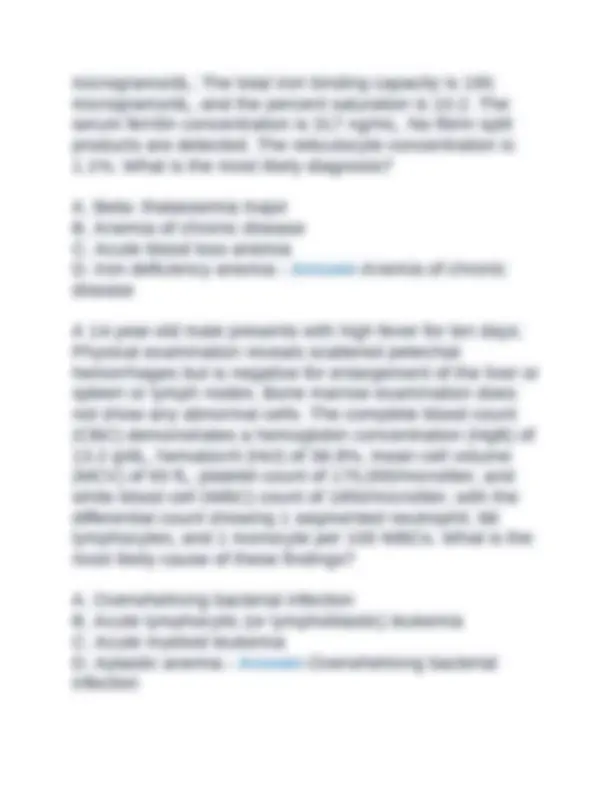
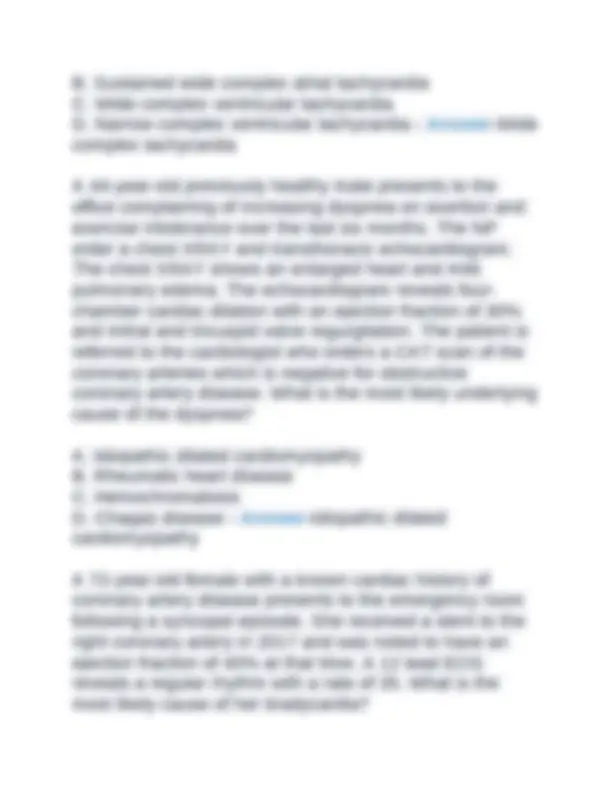
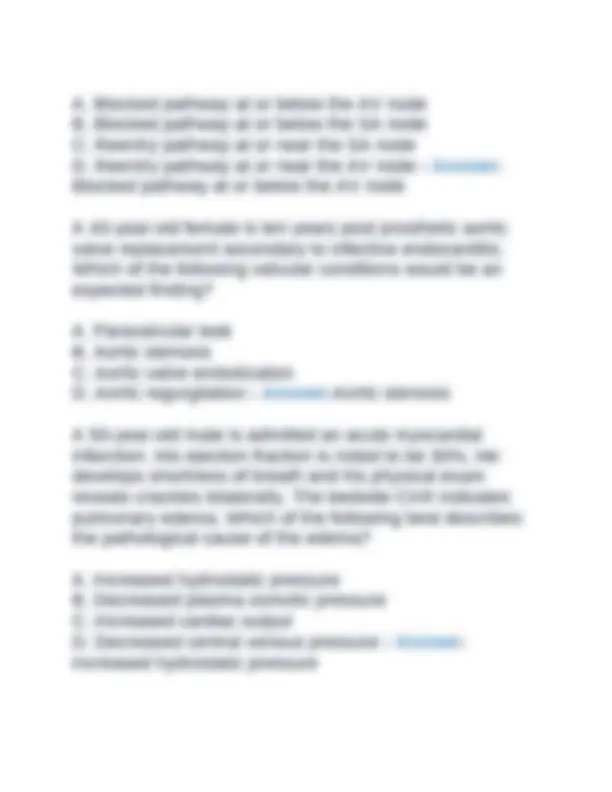
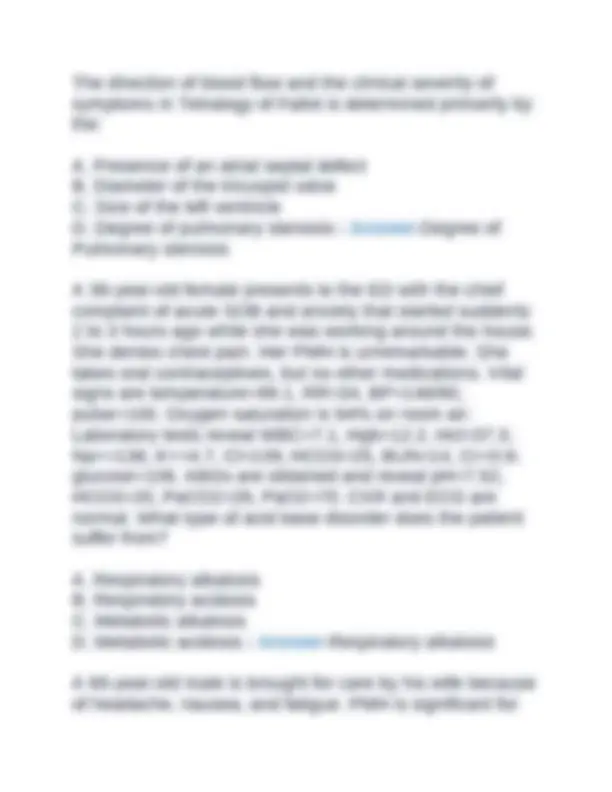
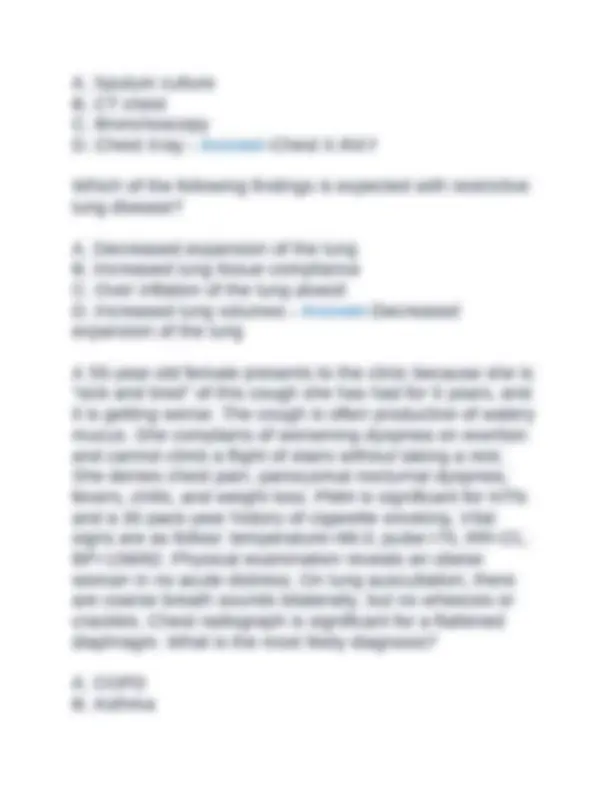

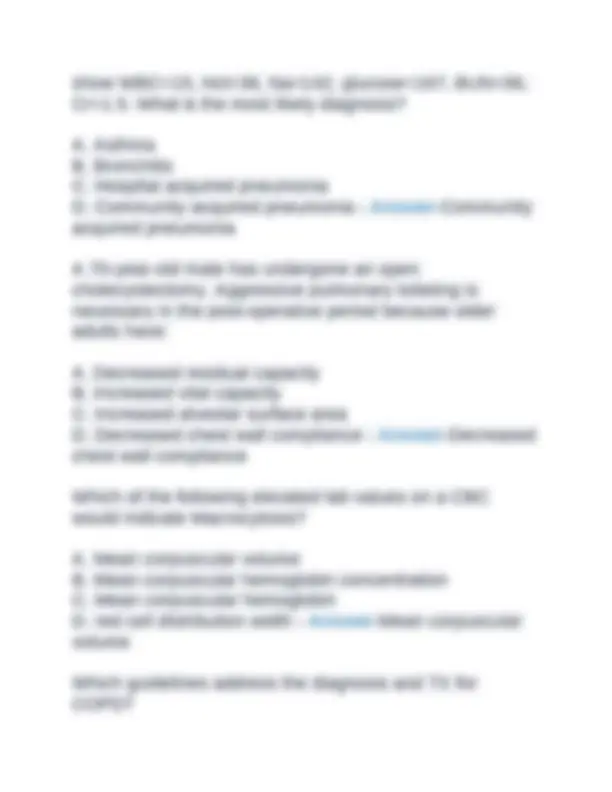
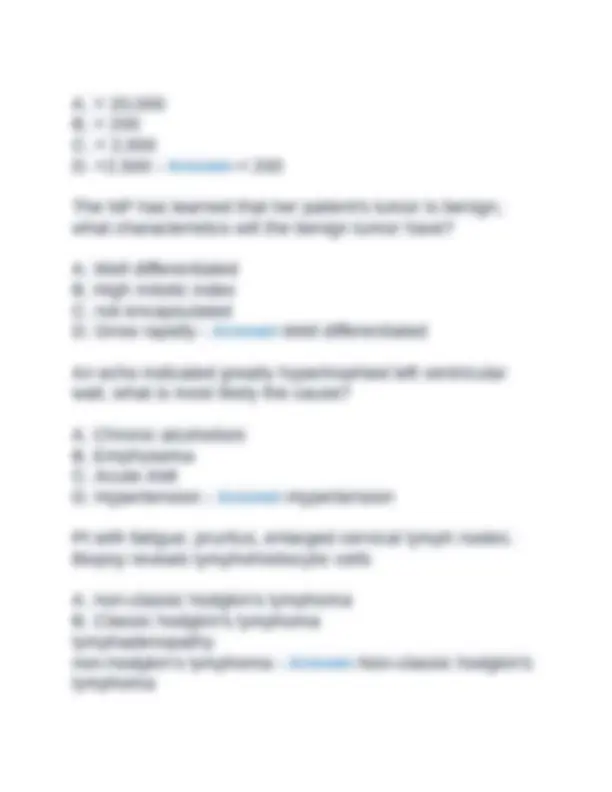
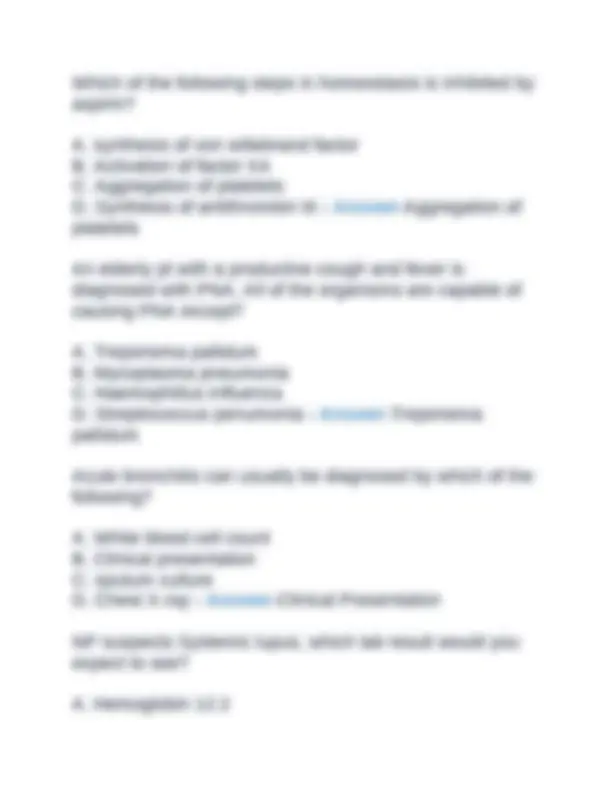
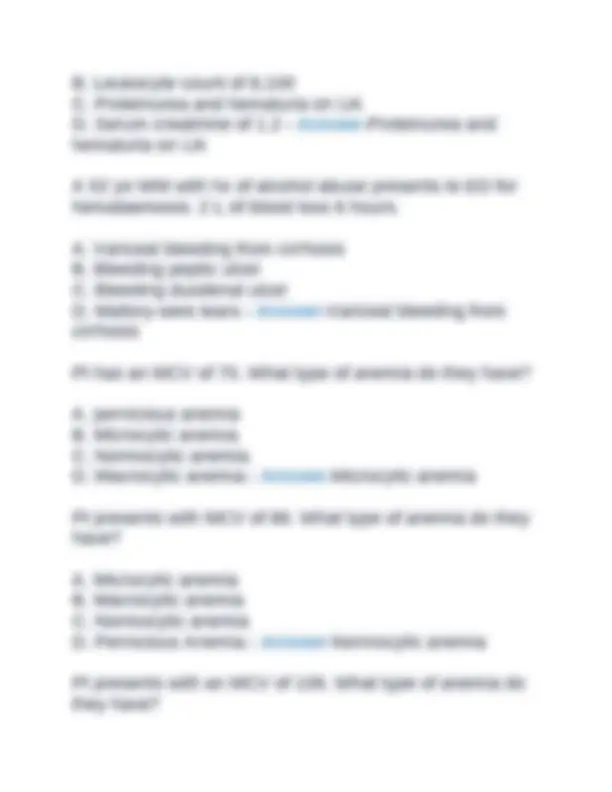
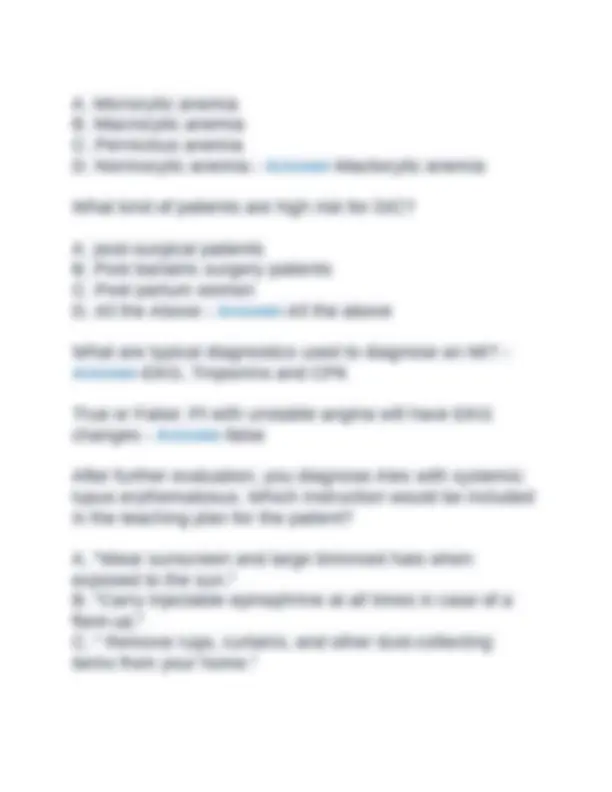
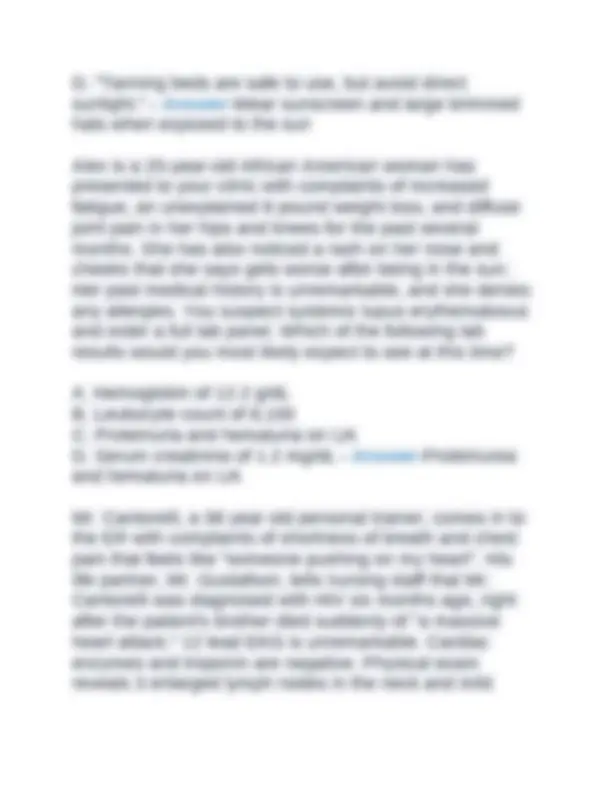
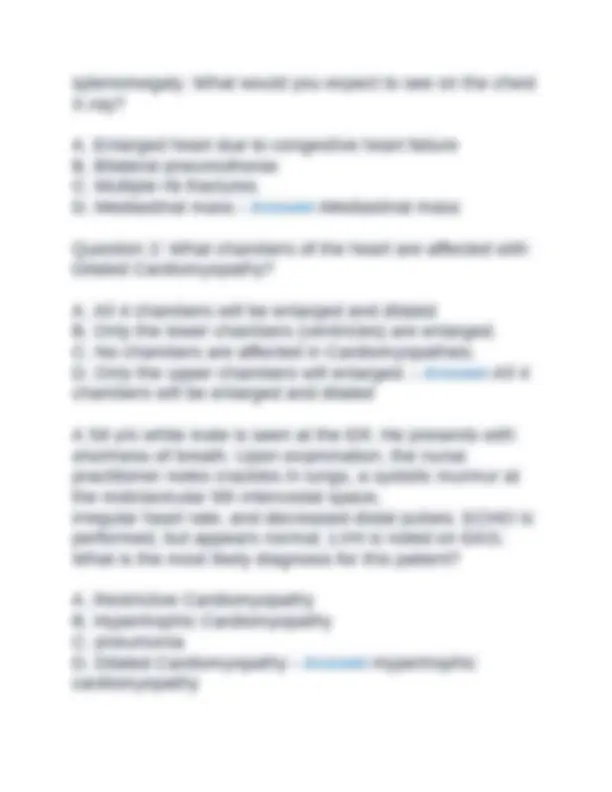
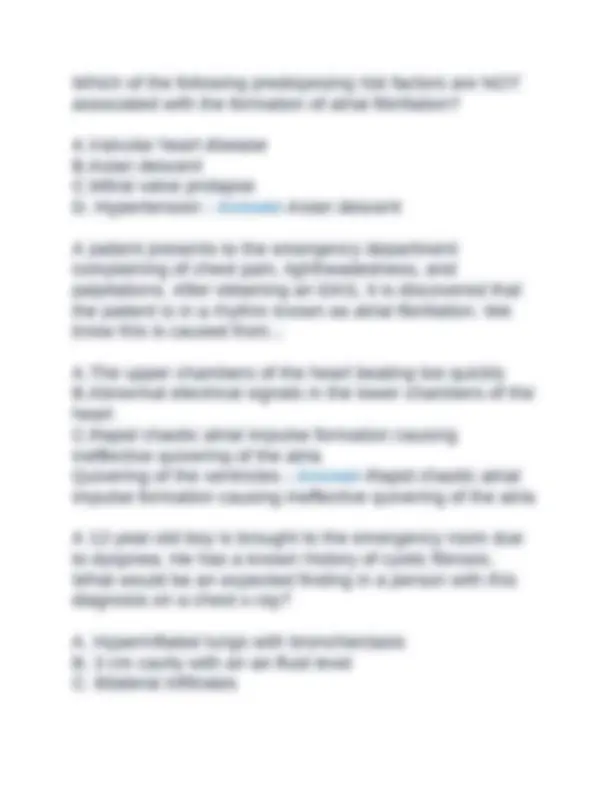
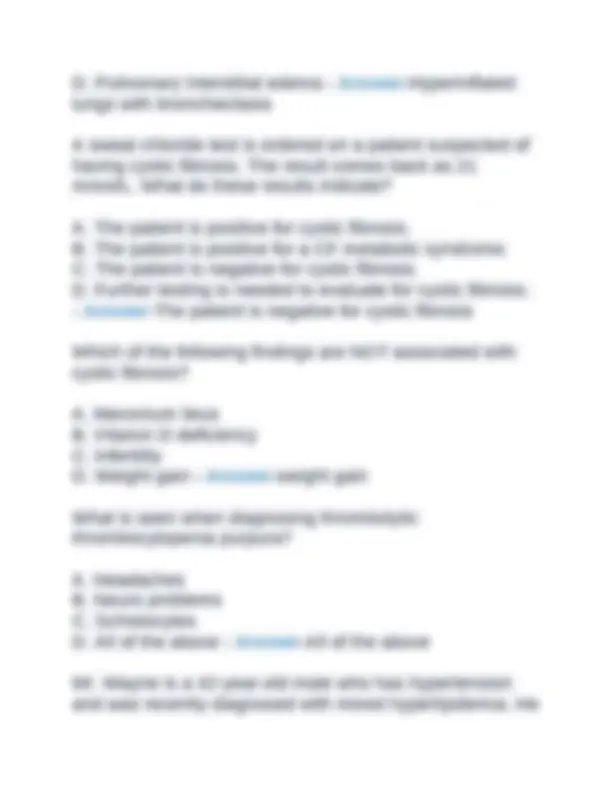
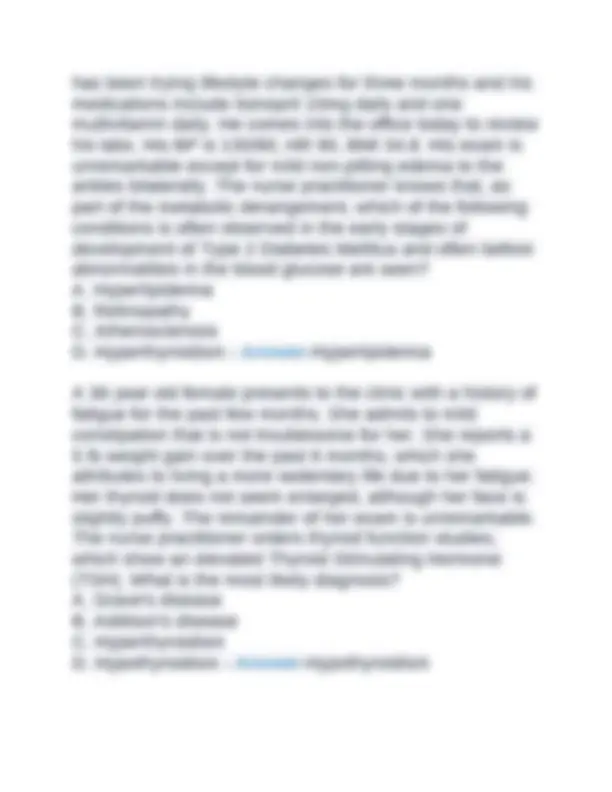
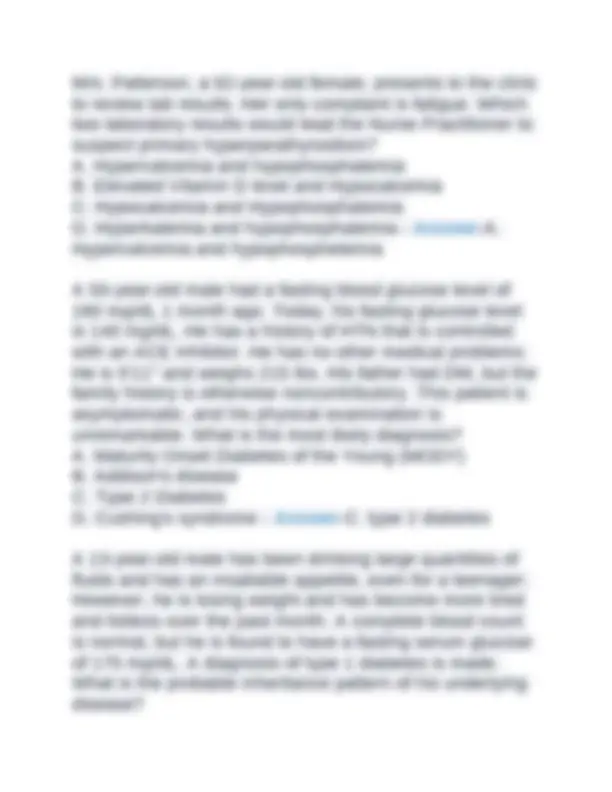
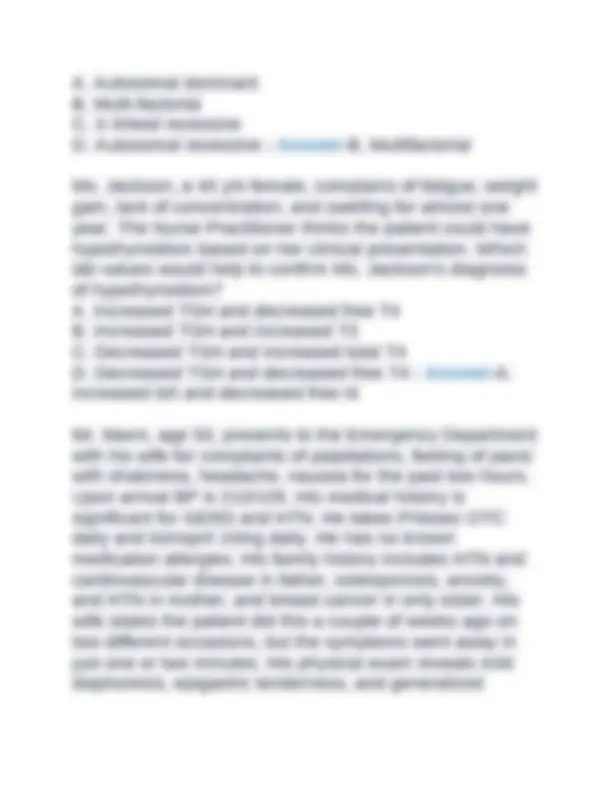
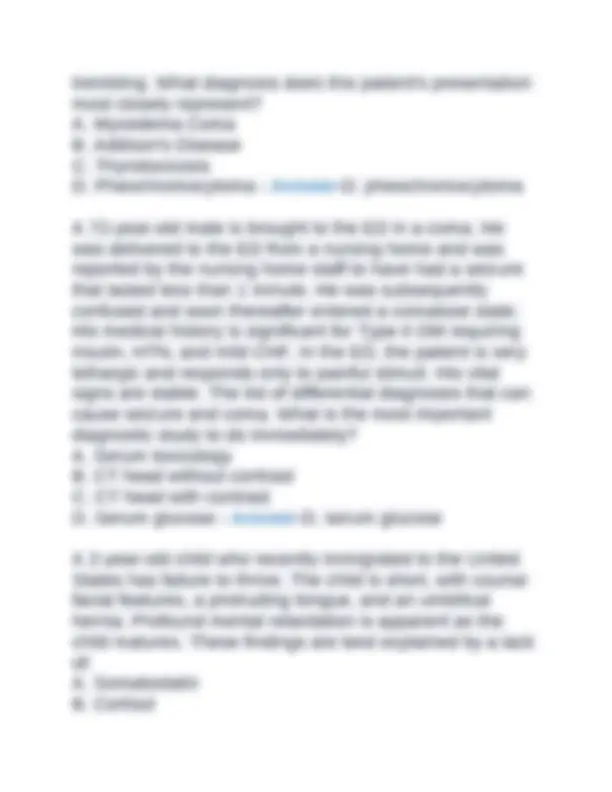
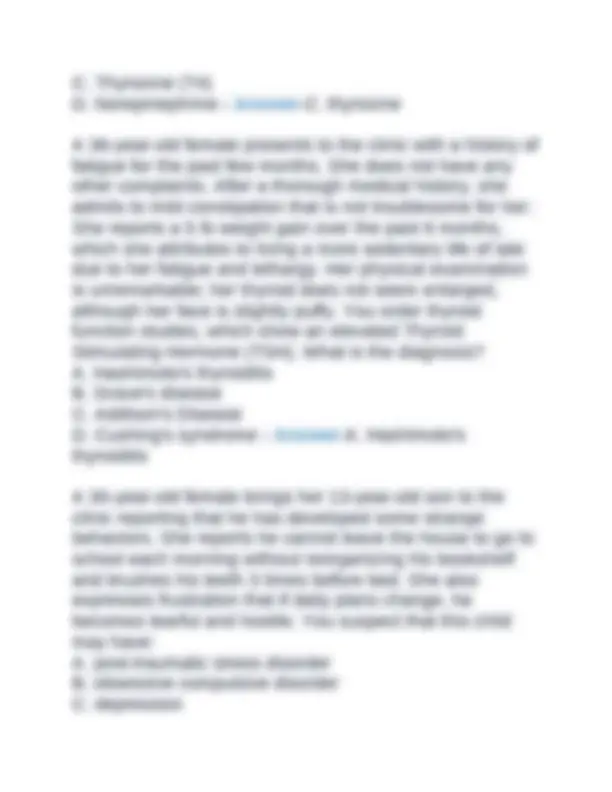
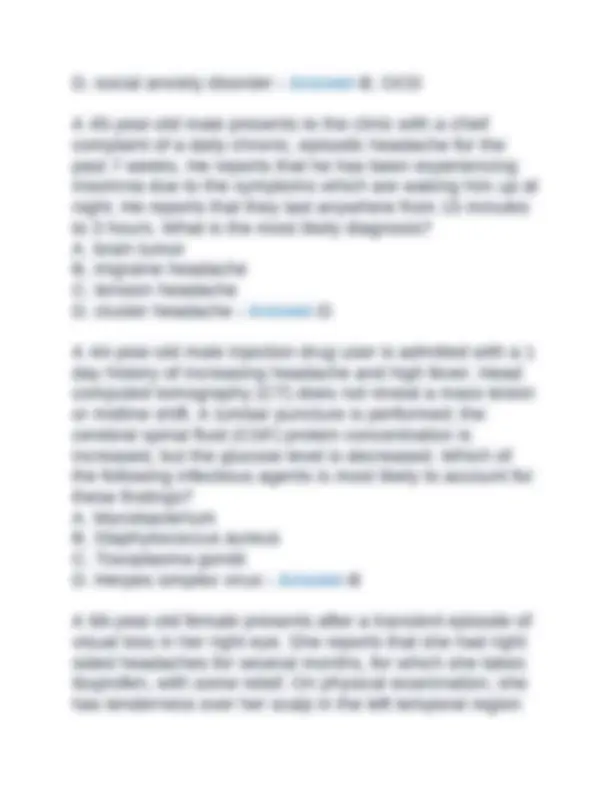
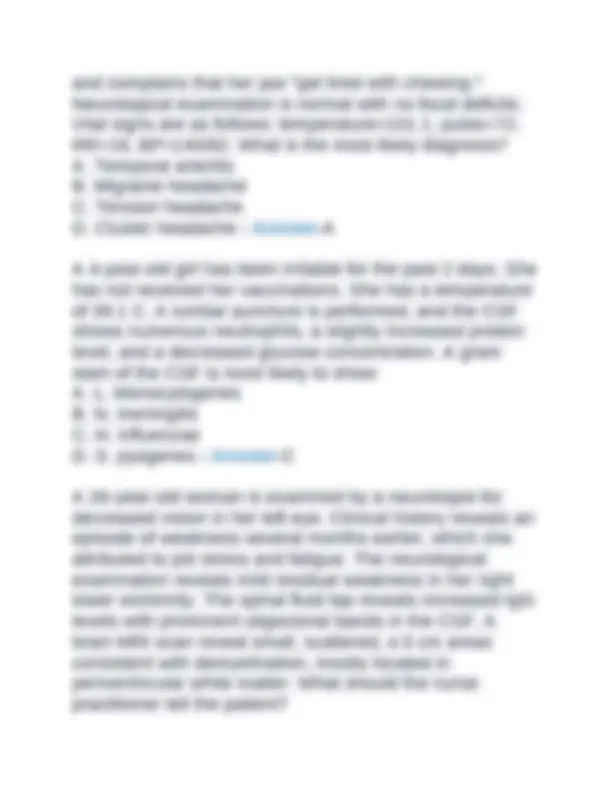
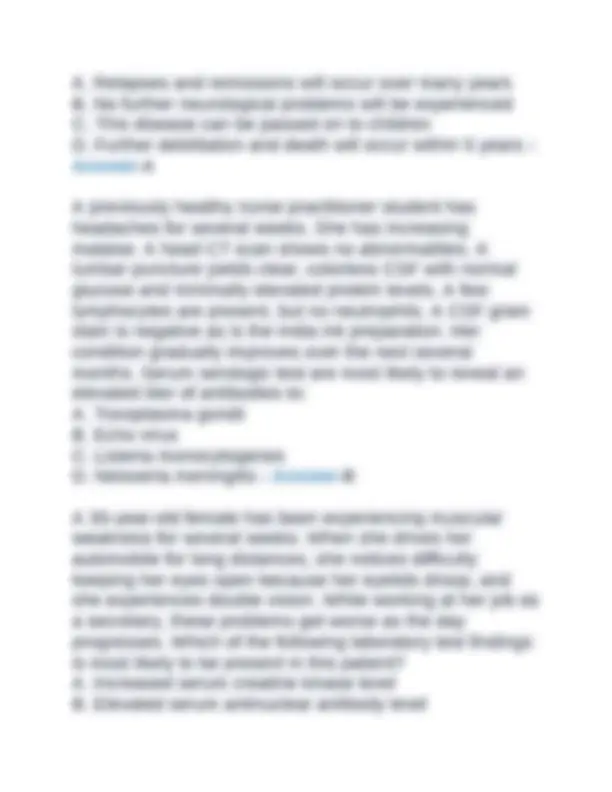
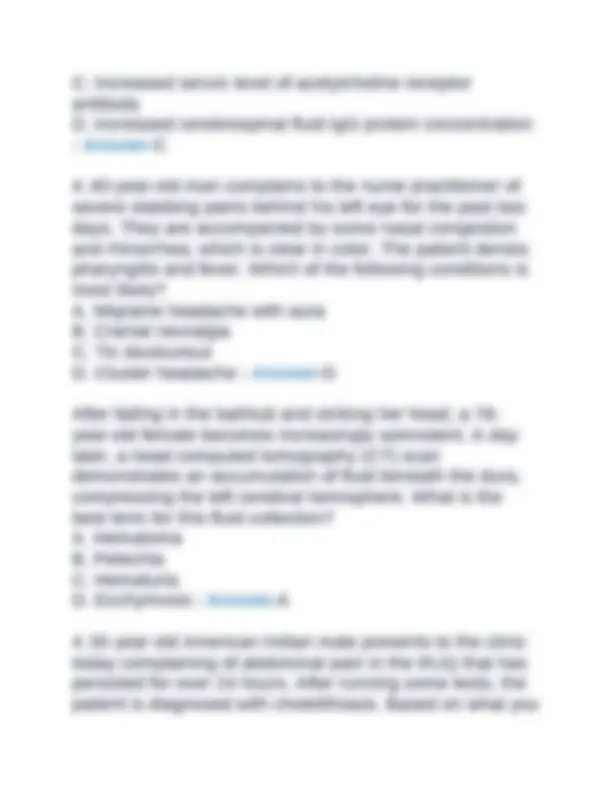
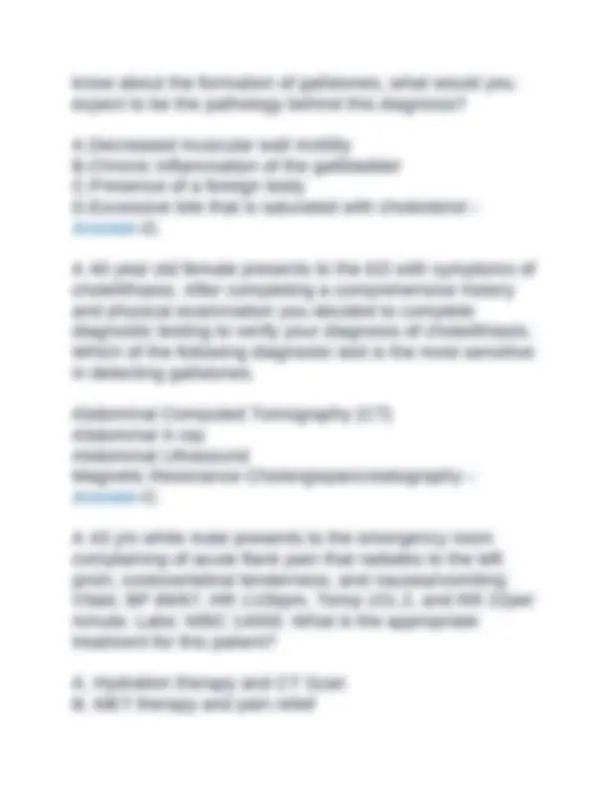
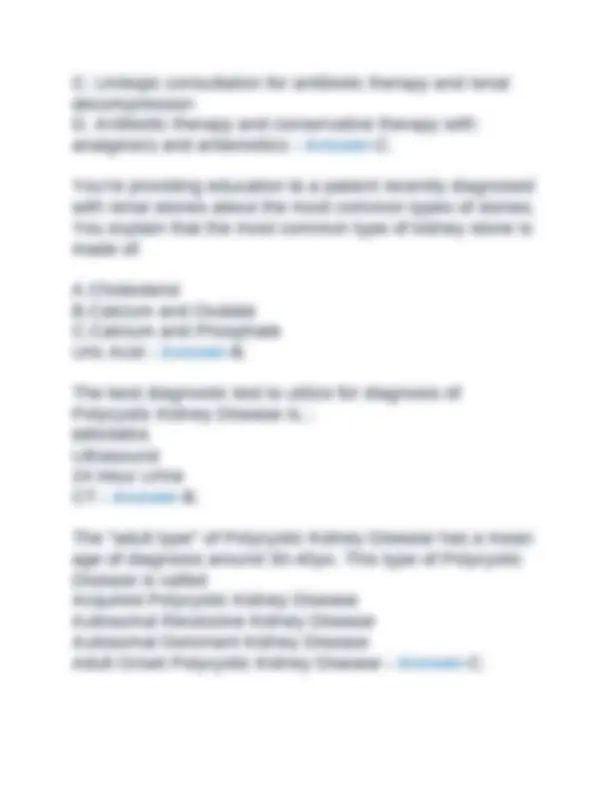
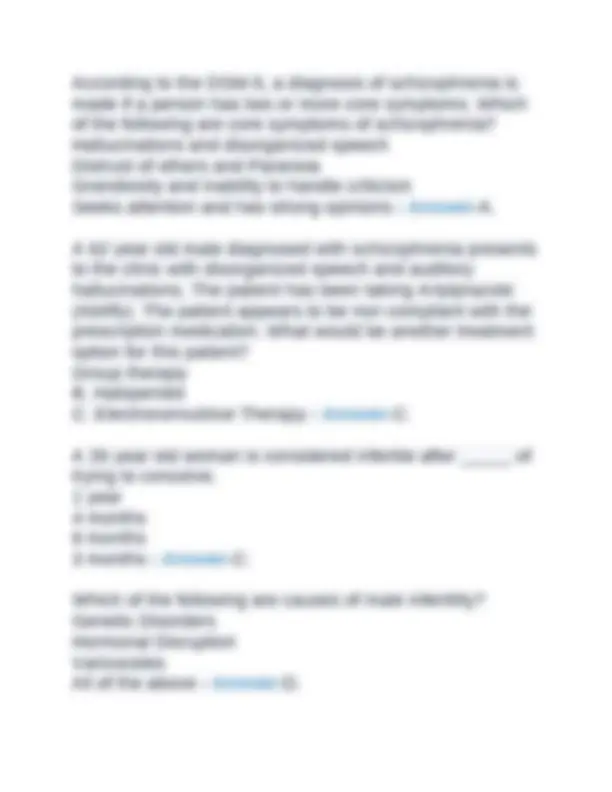

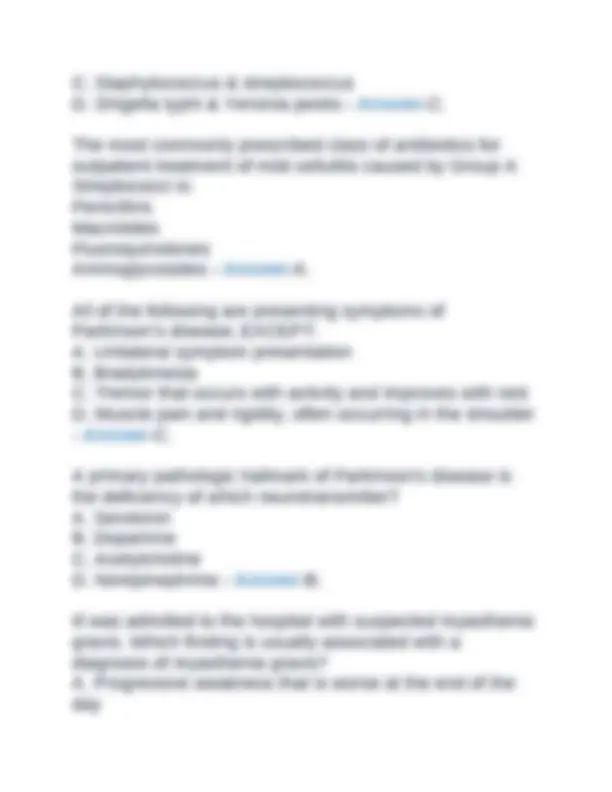
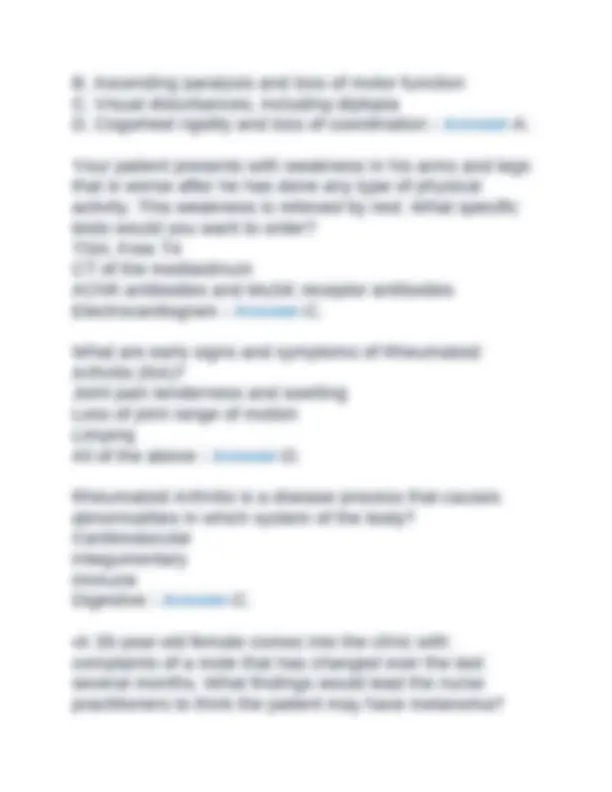
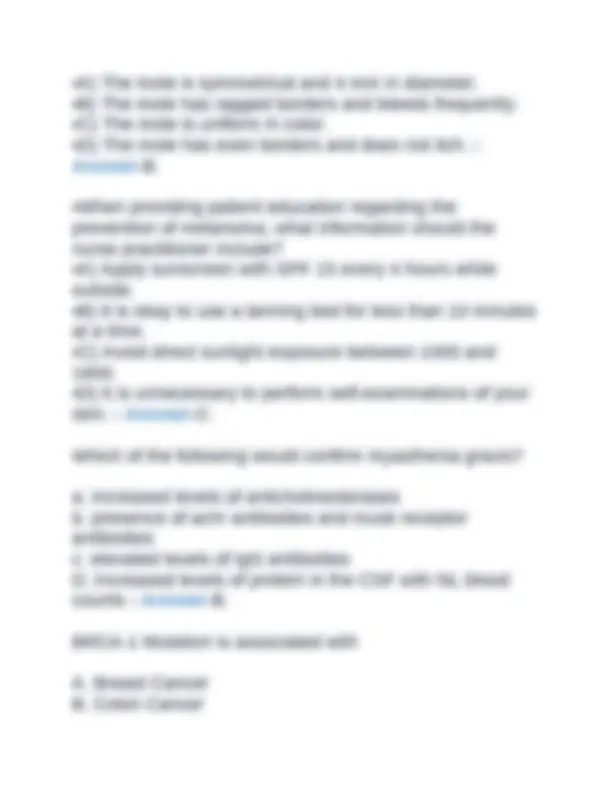
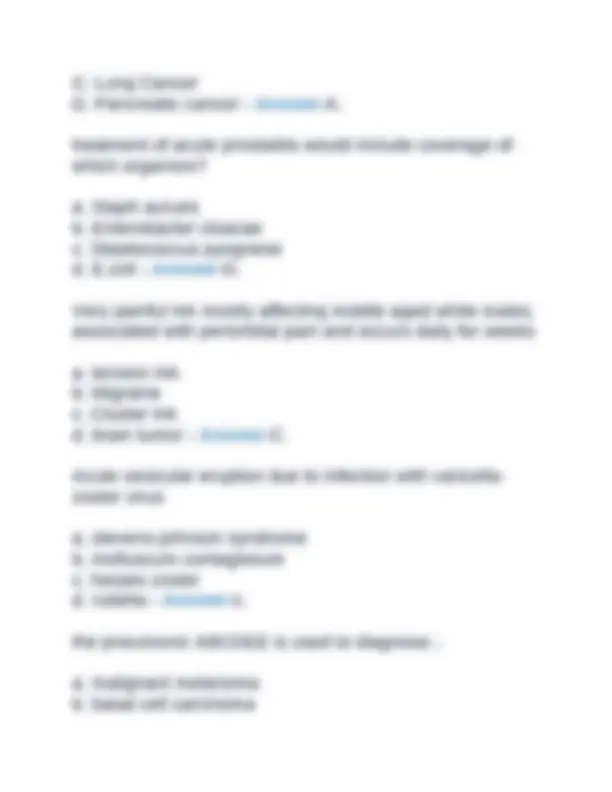
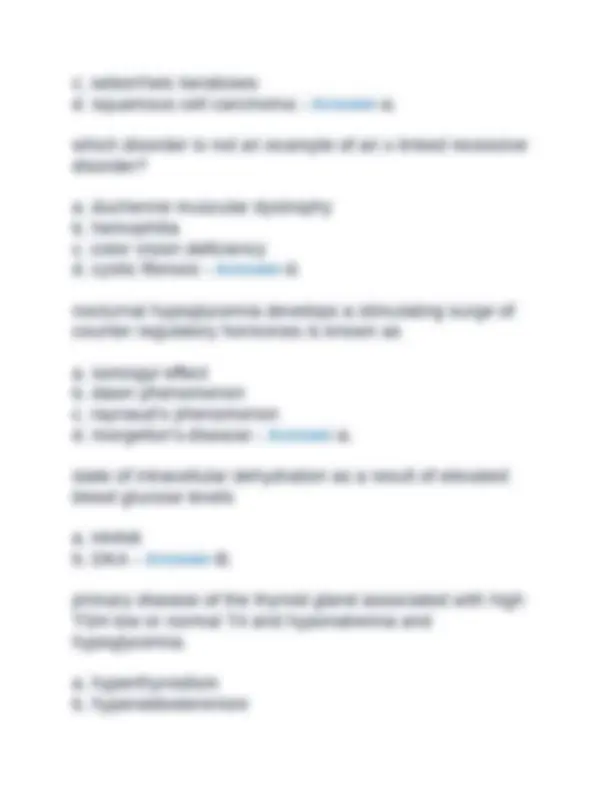

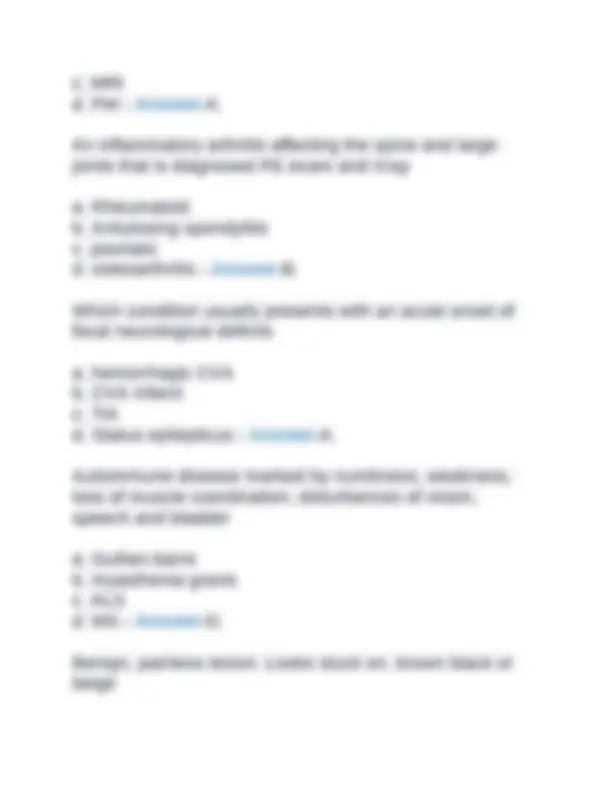
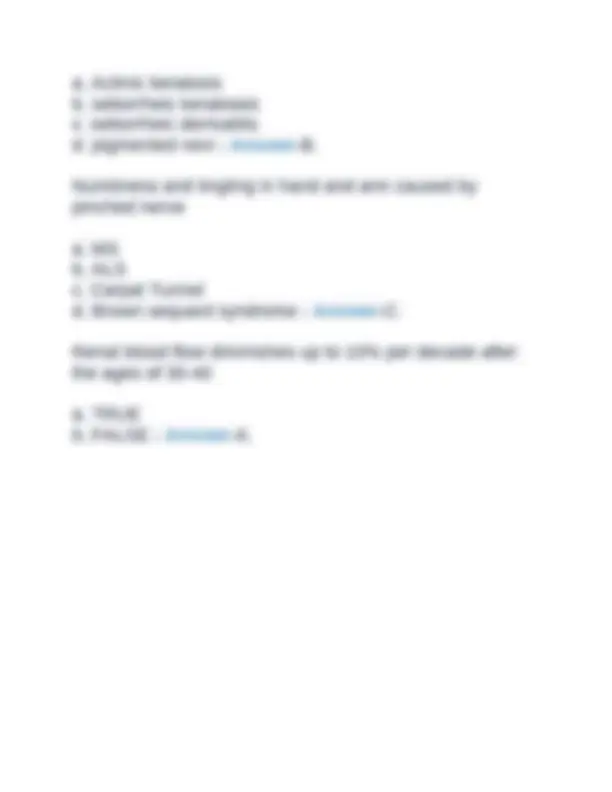


Study with the several resources on Docsity

Earn points by helping other students or get them with a premium plan


Prepare for your exams
Study with the several resources on Docsity

Earn points to download
Earn points by helping other students or get them with a premium plan
Community
Ask the community for help and clear up your study doubts
Discover the best universities in your country according to Docsity users
Free resources
Download our free guides on studying techniques, anxiety management strategies, and thesis advice from Docsity tutors
ADVANCED PATHOPHYSIOLOGY MIDTERM NUR 6501 WALDEN UNIVERSITY / COMPLETE ACTUAL EXAM / 120+ QUESTIONS AND CORRECT DETAILED ANSWERS / 2025/2026 ADVANCED PATHOPHYSIOLOGY MIDTERM NUR 6501 WALDEN UNIVERSITY / COMPLETE ACTUAL EXAM / 120+ QUESTIONS AND CORRECT DETAILED ANSWERS / 2025/2026
Typology: Exams
1 / 46

This page cannot be seen from the preview
Don't miss anything!







































A 4-year-old child appears listless for the last week. He complains of pain when he is picked up by his mother, and he is irritable when touching his arms or legs. Several large ecchymotic lesions have appeared on his right thigh and left shoulder. A complete blood count reveals a HgB=10.2, Hct=30.5%, MCV=96fL, platelet count of 45,000/ML, and WBC count of 13,990/ML. Examination of the peripheral blood smear reveals numerous blasts. The blasts lack peroxidase-positive granules but do contain periodic acid-Schiff (PAS)-positive aggregates and stain positively for TdT. Flow cytometry shows the phenotype of blasts to be CD19+, CD3-, and sIg-. What is the most likely diagnosis? A. Acute lymphoblastic leukemia (ALL) B. Chronic lymphocytic leukemia (CLL) C. Acute myelogenous leukemia (AML) D. Chronic myelogenous leukemia (CML) - Answer -Acute lymphblastic leukemia A 3-year-old child of Italian ancestry presents with failure to thrive. Physical examination indicates
hepatosplenomegaly. His hemoglobin concentration is 6 g/dL, and the peripheral blood smear reveals severely hypochromic microcytic red cells. Total serum iron level is normal. The reticulocyte count is 10%. Hemoglobin electrophoresis shows very little hemoglobin A. A radiograph of the skull shows maxillofacial deformities. What is the principle cause of anemia and other abnormalities in this patient? A. Reduced synthesis of hemoglobin F B. Reduced red blood cell survival from imbalance in the production of alpha and beta globin chains C. Relative deficiency of vitamin B D. Increased fragility of the erythrocyte membrane - Answer -Reduced synthesis of hemoglobin F A 68-year-old previously healthy female has been feeling increasingly tired and weak for several months. She states that she has had black, tarry stools for several weeks. She is found to be anemic with a hemoglobin concentration of 9.3g/dL. The peripheral blood smear reveals microcytic and hypochromic blood cells. Which of the following conditions should be suspected as the most likely of her condition as indicated by the peripheral blood smear? A. Aplastic anemia B. Beta thalassemia C. Gastrointestinal blood loss D. Pernicious anemia - Answer -Gastrointestinal blood loss
Low dose aspirin is commonly used to reduce the risk of arterial thrombosis in patients who have suffered a myocardial infarction. Which one of the following steps in homeostasis is inhibited by aspirin? A. Synthesis of von Willebrand factor B. Aggregation of platelets C. Activation of factor Xa D. Synthesis of antithrombin III - Answer -Aggregation of platelets A 24-year-old presents to the office with fatigue. On physical exam, the NP notices that she ispale with the following vital signs: HR 112, BP 98/64, resp 20, O2 sats 99%. Her CBC shows: WBC6,000, Hemoglobin 9.6, Hematocrit 30.2, MCV is decreased at 76. What is the mostly likely causeof this patient's anemia? A. Iron deficiency anemia caused by menstruation B. Beta Thalassemia of genetic origin C. Pernicious anemia caused by dietary deficiency D. Folate deficiency caused by alcoholism - Answer -Iron deficiency anemia caused by menstruation A 65-year-old female presents to your office complaining of fatigue. She has a long of rheumatoid arthritis. A CBC reveals the following: Hgb=11.6 g/dL, Hct=34.8%, MCV=87 fL/red cell, platelet count of 268,000/microliter, and WBC count of 6800/microliter. The serum haptoglobin level is normal, and the serum iron concentration is 20
micrograms/dL. The total iron binding capacity is 195 micrograms/dL, and the percent saturation is 10.2. The serum ferritin concentration is 317 ng/mL. No fibrin split products are detected. The reticulocyte concentration is 1.1%. What is the most likely diagnosis? A. Beta- thalassemia major B. Anemia of chronic disease C. Acute blood loss anemia D. Iron deficiency anemia - Answer -Anemia of chronic disease A 14-year-old male presents with high fever for ten days. Physical examination reveals scattered petechial hemorrhages but is negative for enlargement of the liver or spleen or lymph nodes. Bone marrow examination does not show any abnormal cells. The complete blood count (CBC) demonstrates a hemoglobin concentration (HgB) of 13.2 g/dL, hematocrit (Hct) of 38.9%, mean cell volume (MCV) of 93 fL, platelet count of 175,000/microliter, and white blood cell (WBC) count of 1850/microliter, with the differential count showing 1 segmented neutrophil, 98 lymphocytes, and 1 monocyte per 100 WBCs. What is the most likely cause of these findings? A. Overwhelming bacterial infection B. Acute lymphocytic (or lymphoblastic) leukemia C. Acute myeloid leukemia D. Aplastic anemia - Answer -Overwhelming bacterial infection
consistent with left ventricular hypertrophy. What is the most likely cause of his syncopal episodes? A. Mitral regurgitation B. Mitral Stenosis C. Aortic regurgitation D. Aortic stenosis - Answer -Aortic stenosis A 63-year-old female presents to the emergency room with sudden onset of severe chest and back pain. She describes the pain as sharp and different from her anginal pain. Her past medical history is positive for HTN X 20 years. VS: HR 105, BP 160/105, RR 17. On physical examination, the NP notices that her pedal and radial pulses are not equal. What is the most likely cause of her chest pain? A. Unstable angina B. Aortic dissection C. Prinzmetal angina D. Acute myocardial infarction - Answer -Aortic dissection A 45-year-old male collapsed suddenly while playing basketball. Bystander CPR and defibrillation was performed using an automatic external defibrillator or AED. When EMS arrived, the gentleman was awake and alert. The recorded rhythm strip on the AED shows tachycardia with AV dissociation (rate, approximately 220 bpm). Which arrhythmia induced his arrest? A. Nonsustained supraventricular tachycardia
B. Sustained wide complex atrial tachycardia C. Wide complex ventricular tachycardia D. Narrow complex ventricular tachycardia - Answer -Wide complex tachycardia A 44-year-old previously healthy male presents to the office complaining of increasing dyspnea on exertion and exercise intolerance over the last six months. The NP order a chest XRAY and transthoracic echocardiogram. The chest XRAY shows an enlarged heart and mild pulmonary edema. The echocardiogram reveals four- chamber cardiac dilation with an ejection fraction of 30% and mitral and tricuspid valve regurgitation. The patient is referred to the cardiologist who orders a CAT scan of the coronary arteries which is negative for obstructive coronary artery disease. What is the most likely underlying cause of the dyspnea? A. Idiopathic dilated cardiomyopathy B. Rheumatic heart disease C. Hemochromatosis D. Chagas disease - Answer -Idiopathic dilated cardiomyopathy A 72-year-old female with a known cardiac history of coronary artery disease presents to the emergency room following a syncopal episode. She received a stent to the right coronary artery in 2017 and was noted to have an ejection fraction of 40% at that time. A 12 lead ECG reveals a regular rhythm with a rate of 35. What is the most likely cause of her bradycardia?
The direction of blood flow and the clinical severity of symptoms in Tetralogy of Fallot is determined primarily by the: A. Presence of an atrial septal defect B. Diameter of the tricuspid valve C. Size of the left ventricle D. Degree of pulmonary stenosis - Answer -Degree of Pulmonary stenosis A 36-year-old female presents to the ED with the chief complaint of acute SOB and anxiety that started suddenly 2 to 3 hours ago while she was working around the house. She denies chest pain. Her PMH is unremarkable. She takes oral contraceptives, but no other medications. Vital signs are temperature=99.1, RR=34, BP=148/90, pulse=100. Oxygen saturation is 94% on room air. Laboratory tests reveal WBC=7.1, Hgb=12.2, Hct=37.3, Na+=138, K+=4.7, Cl=109, HCO3=25, BUN=14, Cr=0.9, glucose=106. ABGs are obtained and reveal pH=7.52, HCO3=20, PaCO2=26, PaO2=70. CXR and ECG are normal. What type of acid base disorder does the patient suffer from? A. Respiratory alkalosis B. Respiratory acidosis C. Metabolic alkalosis D. Metabolic acidosis - Answer -Respiratory alkalosis A 65-year-old male is brought for care by his wife because of headache, nausea, and fatigue. PMH is significant for
small cell carcinoma of the lung diagnosed approximately 2 years ago. He also has a history of TIA (6 years ago) and mild CHF. Vital signs are as follow: temperature=99.8F, RR=18, BP=140/88, pulse=76. On examination, he is awake but somewhat lethargic. Physical examination is unremarkable. Laboratory tests reveal the following: WBC=8.3, Hgb/Hct=10.2/30.7, glucose=106, serum Na+=121 mEq/L, K+=4.3, BUN/Cr= 7.0/0.4. What is the most likely diagnosis? A. Syndrome of Inappropriate Anti-diuretic Hormone (SIADH) B. Diabetic ketoacidosis C. Diabetes Insipidus D. Compensated diastolic congestive heart failure - Answer -SIADH Leo is a 40-year-old male who presents to the clinic with complaints of shortness of breath while doing yard work. He states he has had worsening of the shortness of breath throughout the summer. He states when he was younger, he had shortness of breath and coughed a lot at night. He was given an inhaler for a few years, but he hasn't had any trouble since he was about nine years old. Which findings are most suggestive of a diagnosis of asthma? A. Dry cough during exam, respiratory rate of 20 breaths/minute, and wheezing upon auscultation of posterior lower lung lobes.
A. Sputum culture B. CT chest C. Bronchoscopy D. Chest Xray - Answer -Chest X-RAY Which of the following findings is expected with restrictive lung disease? A. Decreased expansion of the lung B. Increased lung tissue compliance C. Over inflation of the lung alveoli D. Increased lung volumes - Answer -Decreased expansion of the lung A 55-year-old female presents to the clinic because she is "sick and tired" of this cough she has had for 5 years, and it is getting worse. The cough is often productive of watery mucus. She complains of worsening dyspnea on exertion and cannot climb a flight of stairs without taking a rest. She denies chest pain, paroxysmal nocturnal dyspnea, fevers, chills, and weight loss. PMH is significant for HTN and a 35 pack-year history of cigarette smoking. Vital signs are as follow: temperature=99.0, pulse=75, RR=21, BP=158/82. Physical examination reveals an obese woman in no acute distress. On lung auscultation, there are coarse breath sounds bilaterally, but no wheezes or crackles. Chest radiograph is significant for a flattened diaphragm. What is the most likely diagnosis? A. COPD B. Asthma
C. Cor Pulmonale D. Bronchitis - Answer -COPD Two weeks after an 80-year-old female with Staphylococcus aureus pneumonia received a course of antibiotic therapy she returns to the clinic complaining of ongoing fever. She states the productive cough has resolved. A chest radiograph reveals a 3 cm, rounded density in the right lower lobe whose liquefied contents form a central air-fluid level. There are no surrounding infiltrates. What is the most likely cause of the chest Xray results? A. Abscess formation B. Recurrent pneumonia C. Pulmonary fibrosis D. Development of COPD - Answer -Abscess formation A 66-year-old male is brought to the clinic with complaining of productive cough, fever, and chills for the past 2 days. The patient lives with his wife and is retired. PMH is significant for DM, for which he takes insulin; CHF, with an ejection fraction of 40%; and a history of renal insufficiency. He is alert and oriented. There is no history of smoking or alcohol use. On physical examination, he has crackles in the left lower lung. Cardiovascular examination is normal. Vital signs are temperature=103.3, BP=130/64, Pulse=128, RR=24. Oxygen saturation on room air is 97%. CXR shows infiltrates and consolidation in the left lower lobe of the lung. Laboratory test results
D. JNCC VIII - Answer -GOLD When working up your pt for suspected restrictive lung disease, the most important part of the workup is what? A. Complete H&P B. IMAGING C. LABS - Answer -Complete H&P ABG: pH 7.34, PCO2 59, PO2 86, HCO3 28, what is the likely diagnosis? A. Acute metabolic alkalosis B. Acute respiratory acidosis C. Chronic respiratory alkalosis D. Chronic respiratory acidosis - Answer -Chronic respiratory acidosis A 40 yo pt presents with watery diarrhea and abdominal cramps, she took antibiotics for a UTI. What is the likely diagnosis? A. C-Diff B. Helicobacter pylori C. Escherichia coli D. Bacillus cereus - Answer -C-diff
Pulmonary fibrosis, aspiration, and bronchiostasis are examples of restrictive lung disease, which statement is true? A. prohibits air from flowing out of alveoli, trapping air in the lungs B. Prohibits air from flowing into the alveoli by not allowing chest expansion C. There is an increase in the compliance of lung tissue D. Lung volumes are increased - Answer -Prohibits air from flowing into the alveoli by not allowing chest expansion Which of the following signs are associated with hypocalcemia? A. Obturator signs B. Chandelier sign C. Chvostek sign D. Homans sign - Answer -Chvostek sign The most common infection in persons with AIDS? (80% Occurrence) A. pneumocystic pneumonia B. Mycobaterium tuberculosis C. Legionnaires D. Cytomegalovirus - Answer -Pneumocystic pneumonia How low must the CD4+ count be before a patient can be considered as having AIDS?
Which of the following steps in homeostasis is inhibited by aspirin? A. synthesis of von willebrand factor B. Activation of factor XA C. Aggregation of platelets D. Synthesis of antithrombin III - Answer -Aggregation of platelets An elderly pt with a productive cough and fever is diagnosed with PNA, All of the organisms are capable of causing PNA except? A. Treponema pallidum B. Mycoplasma pneumonia C. Haemophlilus Influenza D. Streptococcus penumonia - Answer -Treponema pallidum Acute bronchitis can usually be diagnosed by which of the following? A. White blood cell count B. Clinical presentation C. sputum culture D. Chest X-ray - Answer -Clinical Presentation NP suspects Systemic lupus, which lab result would you expect to see? A. Hemoglobin 12.
B. Leukocyte count of 8, C. Proteinurea and hematuria on UA D. Serum creatinine of 1.2 - Answer -Proteinurea and hematuria on UA A 52 yo WM with hx of alcohol abuse presents to ED for hemataemesis. 2 L of blood loss 6 hours. A. Variceal bleeding from cirrhosis B. Bleeding peptic ulcer C. Bleeding duodenal ulcer D. Mallory-weis tears - Answer -Variceal bleeding from cirrhosis Pt has an MCV of 75. What type of anemia do they have? A. pernicious anemia B. Microcytic anemia C. Normocytic anemia D. Macrocytic anemia - Answer -Microcytic anemia Pt presents with MCV of 86. What type of anemia do they have? A. Microcytic anemia B. Macrocytic anemia C. Normocytic anemia D. Pernicious Anemia - Answer -Normocytic anemia Pt presents with an MCV of 106. What type of anemia do they have?